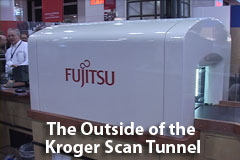From SCDigest's OnTarget e-Magazine
SCDigest Editorial Staff
Jan. 11, 2011
RFID and AIDC News: New Kroger Bar Code Scan Tunnel Could Revolutionize Retail Checkout
High Speed UPC Scan Tunnel at Heart of New Advantage Checkout System; Reducing Billions of Touches Annually; Bearish Bet on RFID in Grocery; What will Kroger Do?
Since May of 2010, grocery retail giant Kroger has been testing a revolutionary new approach to Point of Sale and retail checkout that involves high speed imaging of bar codes or other identifiers to reduce its own labor costs and speed shoppers through the checkout process.
The new technology, which Kroger is calling Advantage Checkout, was for the first time put on display at the National Retail Federation (NRF) "Big Show" conference and exhibition in New York City earlier this week.
SCDigest Says: |
 |
| Now, Kroger has to decide if, how and when it will actually roll the Advantage Checkout system out to its own stores - and potentially make the technology available to other retailers. |
|
What Do You Say?
|
|
|
|
Kroger, a pioneer in self-checkout systems generally, concepted the idea a few years back, and then began work with Fujitsu, an existing POS partner, to develop a pilot system. Two of the Advantage Checkout systems have been installed and been operational in a Kroger store in Hebron, KY since May, according to Lynn Marmer, group vice president for corporate affairs at Kroger.
The heart of the system is a "scan tunnel" similar in a sense to similar tunnels some airlines have tried to deploy to manage the tricky job of scanning baggage bar codes that are oriented in every possible angle.
Inside the Advantage Checkout tunnel are a battery of imaging scanners on all sides capable of not only reading bar codes, but using optical character recognition (OCR) technology to read letters and numbers and potentially to capture a picture of the product as it goes through the tunnel. A scale could also be added to the system, but has not been installed in the pilot system, Kroger says.
The result of all this is a very high read rate of product UPC bar codes despite the huge variation in orientation of the bar codes as products move through the tunnel. Current read rates in the pilot program are 98.5% percent or more, Kroger says.
(The display of the working system at the Fujitsu booth is part of our video review and comment of the NRF 2011 show, available for on-demand viewing here: NRF 2011 Video Review and Comment.)
As an example of how the system can work, if there is a bad bar code on an item, the imager using its OCR capability may still be able to identify the product based on the printed UPC number below the actual bar code.
 A display at the end of tunnel tells a store operator when a product was "seen" but not identified, where quick manual handling of the item would take place. A logical step would be for the system to show a picture of the item that was not successfully scanned to help the store operator quickly identify that item on the belt. Though the system in New York did not use that approach, Kroger CIO Chris Hjelm told SCDigest in New York that it would be easy to add that capability. A display at the end of tunnel tells a store operator when a product was "seen" but not identified, where quick manual handling of the item would take place. A logical step would be for the system to show a picture of the item that was not successfully scanned to help the store operator quickly identify that item on the belt. Though the system in New York did not use that approach, Kroger CIO Chris Hjelm told SCDigest in New York that it would be easy to add that capability.
After a shopper's items have all been placed on the cart, a red bar similar to the separators commonly used today to indicate when one order ends and the next begins is placed on the belt. When the scan tunnel sees that, it notes the order is complete and the POS systems produces a total bill ready for payment.
|